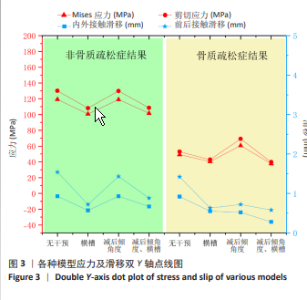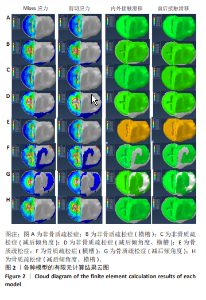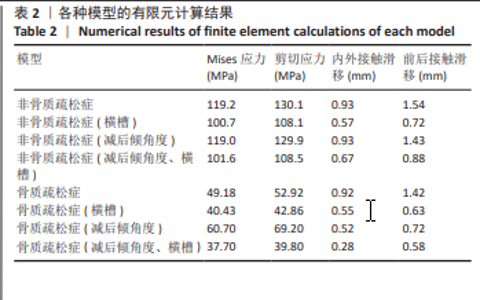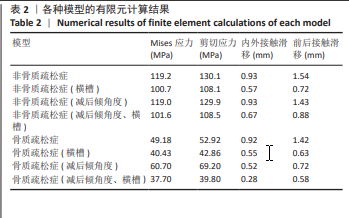Chinese Journal of Tissue Engineering Research ›› 2026, Vol. 30 ›› Issue (9): 2191-2198.doi: 10.12307/2026.541
Previous Articles Next Articles
Finite element analysis of tibial prosthesis loosening after fixed-bearing unicompartmental knee arthroplasty for osteoporosis
Liu Wenlong, Dong Lei, Xiao Zhengzheng, Nie Yu
- Department of Orthopedics, Fuyang People’s Hospital, Fuyang 236000, Anhui Province, China
-
Received:2024-11-07Accepted:2025-02-11Online:2026-03-28Published:2025-09-05 -
Contact:Nie Yu, Chief physician, Department of Orthopedics, Fuyang People’s Hospital, Fuyang 236000, Anhui Province, China -
About author:Liu Wenlong, MS, Physician, Department of Orthopedics, Fuyang People’s Hospital, Fuyang 236000, Anhui Province, China -
Supported by:Fuyang Municipal Health Commission Research Project, No. FY2021-038 (to NY)
CLC Number:
Cite this article
Liu Wenlong, Dong Lei, Xiao Zhengzheng, Nie Yu. Finite element analysis of tibial prosthesis loosening after fixed-bearing unicompartmental knee arthroplasty for osteoporosis[J]. Chinese Journal of Tissue Engineering Research, 2026, 30(9): 2191-2198.
share this article
Add to citation manager EndNote|Reference Manager|ProCite|BibTeX|RefWorks

2.1 开横槽后的结果 开横槽后的应力峰值均略小于不开横槽的应力峰值,这可能与接触面积增加有关。值得注意的是,在非骨质疏松症情况下,内外滑移降低39%,前后滑移降低53%;在骨质疏松症情况下,内外滑移降低40%,前后滑移降低56%(表2,图3)。 2.2 减后倾角度后的结果 减后倾角度后非骨质疏松症模型的应力峰值及接触滑移峰值无明显改变。不同的是,骨质疏松症模型的Mises应力峰值增加23%,剪切应力峰值增加31%,内外接触滑移减少43%,前后接触滑移减少49%(表2,图3)。这可能是因为减后倾角度后的皮质骨承担了更多载荷从而导致模型应力峰值增加,对应的是松质骨承担载荷减少。 2.3 同时减后倾角度和开横槽后的结果 非骨质疏松症模型的应力及滑移峰值均有所下降,Mises应力峰值减小15%,剪切应力峰值减少17%,内外滑移降低28%,前后滑移降低43%。对于骨质疏松症模型的应力及滑移峰值同样有所降低,Mises应力峰值减小23%,剪切应力峰值减少25%,内外滑移降低70%,前后滑移降低59%(表2,图3)。"

| [1] PIRES DPDC, MONTE FAD, MONTEIRO LF, et al. Updates in the Treatment of Knee Osteoarthritis. Rev Bras Ortop (Sao Paulo). 2024; 59(3):e337-e348. [2] LI H, GE M. Different surgical treatment modalities for single-compartment knee osteoarthritis: A Bayesian network meta-analysis of randomized controlled trials. Meds Clin Med. 2024;5(3). https://doi.org/10.21203/rs.3.rs-2919857/v1. [3] RUI C, AN’GANG C, LIPING Z, et al. Effect of unicompartmental knee arthroplasty combined with arthroscopic debridement on knee osteoarthritis and analysis of risk factors of deep venous thrombosis. Am J Transl Res. 2023;15(2):1343-1351. [4] 陆兮, 刘玉杰, 郭旗, 等. 单髁置换术治疗老年人内侧单间室膝骨关节炎的临床疗效[J]. 中华老年多器官疾病杂志,2016,15(5): 321-325+316. [5] 马尚, 王上增. 单室膝骨关节炎单髁与全膝置换术短期效果比较[J]. 中国矫形外科杂志,2021,29(15):1359-1363. [6] 黄强, 曾羿, 胡钦胜, 等. 单髁关节置换术与全膝关节置换术治疗膝关节内侧间室重度骨关节炎的比较研究[J]. 中国修复重建外科杂志,2021,35(9):1125-1132. [7] SUAREZ JC, SAXENA A, ARGUELLES W, et al. Unicompartmental Knee Arthroplasty vs Total Knee Arthroplasty: A Risk-adjusted Comparison of 30-day Outcomes Using National Data From 2014 to 2018. Arthroplast Today. 2022;17:114-119. [8] 王方兴, 薛华明, 马童, 等. 人工单髁关节置换术治疗超高龄膝关节骨关节炎患者的近期疗效[J]. 中国修复重建外科杂志,2019, 33(8):947-952. [9] BUM CC, KYUN KT, GWI KY, et al. Prevalence of osteoporosis in female patients with advanced knee osteoarthritis undergoing total knee arthroplasty. J Korean Med Sci. 2014;29(10):1425-1431. [10] JOHNSTON CB, DAGAR M. Osteoporosis in older adults. Med Clin N Am. 2020;104(5):873-884. [11] HE Z, CHU L, LIU X, et al. Differences in subchondral trabecular bone microstructure and finite element analysis-based biomechanical properties between osteoporosis and osteoarthritis. J Orthop Translat. 2020;24:39-45. [12] EREMINA GM, SMOLIN AY. Risk assessment of resurfacing implant loosening and femur fracture under low-energy impacts taking into account degenerative changes in bone tissues. Computer simulation. Comput Methods Programs Biomed. 2021;200:105929. [13] LUN XP, JEN HC, GUANG MY, et al. Prevalence and treatment rate of osteoporosis in patients undergoing total knee and hip arthroplasty: a systematic review and meta-analysis. Arch Osteoporos. 2022;17(1). https://doi.org/10.1007/s11657-021-01055-9. [14] 曾健康, 乔永杰, 李嘉欢, 等. 关节假体无菌松动发生机理的研究现状[J]. 中国矫形外科杂志,2024,32(5):422-427. [15] OTSUKA Y, MIYASHITA Y, MUTOH Y. Effects of delamination on fretting wear behaviors of plasma-sprayed hydroxyapatite coating. Mech Eng J. 2016;3(2):15-00573-15. https://doi.org/10.1299/mej.15-00573. [16] JONES MD, BUCKLE CL. How does aseptic loosening occur and how can we prevent it? Orthop Trauma. 2020;34(3):146-152. [17] BESIER TF, GOLD GE, BEAUPRÉ GS, et al. A modeling framework to estimate patellofemoral joint cartilage stress in vivo. Med Sci Sports Exerc. 2005;37(11):1924-1930. [18] 熊华章, 曾羿, 斯海波, 等. 膝内侧间室骨关节炎单髁置换术有限元分析研究进展[J]. 中国修复重建外科杂志,2021,35(6):781-785. [19] KYOUNG-TAK K, OH-RYONG K, JUHYUN S, et al. Effect of joint line preservation on mobile-type bearing unicompartmental knee arthroplasty: finite element analysis. Australas Phys Eng Sci Med. 2018;41(1):201-208. [20] 蒋利锋, 章淼锋, 朱苏南, 等. 活动平台单髁假体的三维有限元模型建立及受力分析[J]. 生物骨科材料与临床研究,2015,12(2):69-72. [21] KWON OR, KANG KT, SON T, et al. Biomechanical comparison of fixed- and mobile-bearing for unicomparmental knee arthroplasty using finite element analysis. J Orthop Res. 2014;32(2):338-345. [22] NAGENTRAU M, TOBI ALM, JAMIAN S, et al. Contact slip prediction in HAp coated artificial hip implant using finite element analysis. Mech Eng J. 2019;6(3): 18-00562-18. https://doi.org/10.1299/mej.18-00562. [23] MOHD MOIDEEN IS, LIM CT, YEOW RCH, et al. Polka dot cementless talar component in enhancing total ankle replacement fixation: A parametric study using the finite element analysis approach. Comput Biol Med. 2022;141:105142. [24] FARRON A, TERRIER A, BÜCHLER P. Risks of loosening of a prosthetic glenoid implanted in retroversion. J Shoulder Elbow Surg. 2006;15(4): 521-526. [25] EGALBUSERA F, EFREUTEL M, EDüRSELEN L, et al. Material models and properties in the finite element analysis of knee ligaments: a literature review. Front Bioeng Biotechnol. 2014;2:54. [26] LI L, YANG L, ZHANG K, et al. Three-dimensional finite-element analysis of aggravating medial meniscus tears on knee osteoarthritis. J Orthop Translat. 2020;20:47-55. [27] LI L, YANG X, YANG L, et al. Biomechanical analysis of the effect of medial meniscus degenerative and traumatic lesions on the knee joint. Am J Transl Res. 2019;11(2):542-556. [28] CHHABRA A, ASHIKYAN O, HLIS R, et al. The International Society of Arthroscopy, Knee Surgery and Orthopaedic Sports Medicine classification of knee meniscus tears: three-dimensional MRI and arthroscopy correlation. Eur Radiol. 2019; 29(11):6372-6384. [29] MONONEN ME, JURVELIN JS, KORHONEN RK. Effects of radial tears and partial meniscectomy of lateral meniscus on the knee joint mechanics during the stance phase of the gait cycle--A 3D finite element study. J Orthop Res. 2013;31(8):1208-1217. [30] ASHKAN V, HAMID NH, ARVINDER S, et al. Influence of meniscectomy and meniscus replacement on the stress distribution in human knee joint. Ann Biomed Eng. 2008;36(8):1335-1344. [31] DONAHUE TLH, HULL ML, RASHID MM, et al. How the stiffness of meniscal attachments and meniscal material properties affect tibio-femoral contact pressure computed using a validated finite element model of the human knee joint. J Biomech. 2003;36(1):19-34. [32] 刘蒙飞, 陈刚, 史易晗, 等. 骨质疏松患者单髁置换过程中股骨假体置入位置优化的有限元分析[J]. 中国组织工程研究,2025, 29(3):464-470. [33] ARMILLOTTA N, BORI E, INNOCENTI B. Finite element analysis of malposition in bi-unicompartmental knee arthroplasty. Arch Orthop Trauma Surg. 2023;143(6):3447-3455. [34] STODDART JC, GARNER A, TUNCER M, et al. The risk of tibial eminence avulsion fracture with bi-unicondylar knee arthroplasty : a finite element analysis. Bone Joint Res. 2022;11(8):575-584. [35] WENLONG L, XIAOXIN S, WENJING L, et al. Finite element study of a partial meniscectomy of a complete discoid lateral meniscus in adults. Med Eng Phys. 2022;107:103855. [36] GAMBLE JG, ABDALLA AB, MEADOWS MG, et al. Radial Width of the Lateral Meniscus at the Popliteal Hiatus: Relevance to Saucerization of Discoid Lateral Menisci. Am J Sports Med. 2021;50(1): 3635465211056661. [37] KIAPOUR A, KIAPOUR AM, KAUL V, et al. Finite element model of the knee for investigation of injury mechanisms: development and validation. J Biomech Eng. 2014;136(1):011002. [38] TAKAFUMI H, YOSHIHITO S, TOMOYUKI K, et al. Bearing separation from the lateral wall of the tibial component is a risk of anterior dislocation of the mobile-bearing in Oxford unicompartmental knee arthroplasty. J Arthroplasty. 2022;37(5):942-947. [39] ZHAO JL, JIN X, HUANG HT, et al. Analysis of the causes of primary revision after unicompartmental knee arthroplasty: A case series. World J Clin Cases. 2024;12(9):1560-1568. [40] 马锐祥, 李乾明, 张贤祚, 等. 活动平台与固定平台单髁置换治疗膝内侧单间室骨关节炎的短期疗效及成本对比[J]. 安徽医学, 2021,42(9):1043-1046. [41] KOH YG, PARK KM, KANG K, et al. Finite element analysis of the influence of the posterior tibial slope on mobile-bearing unicompartmental knee arthroplasty. Knee. 2021;29:116-125. [42] ZHANG P, WANG YL, LIU L, et al. Biomechanical finite element analysis of various tibial plateau posterior tilt angles in medial unicondylar knee arthroplasty. Exp Ther Med. 2024;28(3):353. |
| [1] | Chen Huiting, Zeng Weiquan, Zhou Jianhong, Wang Jie, Zhuang Congying, Chen Peiyou, Liang Zeqian, Deng Weiming. Tail anchoring technique of vertebroplasty in treatment of osteoporotic vertebral compression fractures with intravertebral cleft: a finite element analysis [J]. Chinese Journal of Tissue Engineering Research, 2026, 30(9): 2145-2152. |
| [2] | Zeng Xuan, Weng Rui, Ye Shicheng, Tang Jiadong, Mo Ling, Li Wenchao. Two lumbar rotary manipulation techniques in treating lumbar disc herniation: a finite element analysis of biomechanical differences [J]. Chinese Journal of Tissue Engineering Research, 2026, 30(9): 2153-2161. |
| [3] | Cheng Qisheng, Julaiti·Maitirouzi, Xiao Yang, Zhang Chenwei, Paerhati·Rexiti. Finite element analysis of novel variable-diameter screws in modified cortical bone trajectory of lumbar vertebrae [J]. Chinese Journal of Tissue Engineering Research, 2026, 30(9): 2162-2171. |
| [4] | Liu Jiafu, Ren Ruxia, Liao Zhouwei, Zhou Xiali, Wu Yihong, Zhang Shaoqun. Three-dimensional finite element analysis of cervical spine biomechanical characteristics in a rat model of cervical vertigo [J]. Chinese Journal of Tissue Engineering Research, 2026, 30(9): 2182-2190. |
| [5] | Zhou Daobin, Wang Kehao, Xie Yang, Ning Rende. Biomechanical characteristics of volar locking plate only versus combined dorsal mini-plate fixation of distal radius fractures with dorsal ulnar fragment [J]. Chinese Journal of Tissue Engineering Research, 2026, 30(9): 2255-2261. |
| [6] | Zheng Wangyang, Fei Ji, Yang Di, Zhao Lang, Wang Lingli, Liu Peng, Li Haiyang. Finite element analysis of the force changes of the supraspinatus tendon and glenohumeral joint during the abduction and flexion of the humerus [J]. Chinese Journal of Tissue Engineering Research, 2026, 30(9): 2199-2207. |
| [7] | Cai Qirui, Dai Xiaowei, Zheng Xiaobin, Jian Sili, Lu Shaoping, Liu Texi, Liu Guoke, Lin Yuanfang. Mechanical effects of Long’s traction orthopedic method on cervical functional units: quantitative analysis of biomechanical model of head and neck [J]. Chinese Journal of Tissue Engineering Research, 2026, 30(9): 2208-2216. |
| [8] | Rao Jingcheng, Li Yuwan, Zheng Hongbing, Xu Zhi, Zhu Aixiang, Shi Ce, Wang Bing, Yang Chun, Kong Xiangru, Zhu Dawei. Biomechanical differences between the new proximal femoral stable intramedullary nail and traditional intramedullary nail#br# [J]. Chinese Journal of Tissue Engineering Research, 2026, 30(9): 2217-2225. |
| [9] | Chen Long, Wang Xiaozhen, Xi Jintao, Lu Qilin. Biomechanical performance of short-segment screw fixation combined with expandable polyetheretherketone vertebral body replacement in osteoporotic vertebrae [J]. Chinese Journal of Tissue Engineering Research, 2026, 30(9): 2226-2235. |
| [10] | Zhang Zizheng, Luo Wang, Liu Changlu. Application value of finite element analysis on unicompartmental knee arthroplasty for medial knee compartmental osteoarthritis [J]. Chinese Journal of Tissue Engineering Research, 2026, 30(9): 2313-2322. |
| [11] | Zhao Feifan, Cao Yujing. Risk factors and coping strategies of internal fixation failure in treatment of intertrochanteric fracture with proximal femoral nail antirotation [J]. Chinese Journal of Tissue Engineering Research, 2026, 30(9): 2323-2333. |
| [12] | Zheng Xuying, Hu Hongcheng, Xu Libing, Han Jianmin, Di Ping. Stress magnitude and distribution in two-piece cement-retained zirconia implants under different loading conditions and with varying internal connection shapes [J]. Chinese Journal of Tissue Engineering Research, 2026, 30(8): 1979-1987. |
| [13] | Hu Xiongke, Liu Shaohua, Tan Qian, Liu Kun, Zhu Guanghui. Shikonin intervention with bone marrow mesenchymal stem cells improves microstructure of femur in aged mice [J]. Chinese Journal of Tissue Engineering Research, 2026, 30(7): 1609-1615. |
| [14] | Wu Zhilin, , He Qin, Wang Pingxi, Shi Xian, Yuan Song, Zhang Jun, Wang Hao . DYRK2: a novel therapeutic target for rheumatoid arthritis combined with osteoporosis based on East Asian and European populations [J]. Chinese Journal of Tissue Engineering Research, 2026, 30(6): 1569-1579. |
| [15] | Zhang Haiwen, Zhang Xian, Xu Taichuan, Li Chao. Bibliometric and visual analysis of the research status and trends of senescence in osteoporosis [J]. Chinese Journal of Tissue Engineering Research, 2026, 30(6): 1580-1591. |
| Viewed | ||||||
|
Full text |
|
|||||
|
Abstract |
|
|||||



